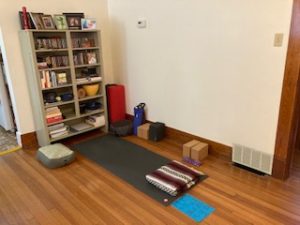
by Charissa Loftis
For yoga practitioners, yoga teachers, and yoga therapists, establishing a home practice can be rather elusive. Because I recently celebrated my seven-year anniversary of daily practice, I wanted to share some tips for starting, or re-sparking, your own daily home practice.
1. Set aside a dedicated space for your practice.
You really only need a space the size of your mat. If you can leave your mat out, you’ve already removed the hurdle of finding a space to practice. It took me a while to settle on a space that felt right, but my dedicated space is just 8 feet by 4.5 feet and that includes a bookcase. I do have wood floors now but had carpet over the wood before that. (For those practicing on a carpet, I invested in a Manduka mat because they are heavy enough to practice on carpet without buckling under you.)
2. Be realistic about how much time you have.
Your yoga practice does not have to be an hour long. What do you actually have time for? If you’re realistic about the length of time you can easily commit to (10 minutes is a great place to start), it’s easier to practice regularly.
3. Be flexible and give yourself permission to do less.
For a variety of reasons, there are days that you will not feel like practicing. On those days, give yourself permission to do as little as possible. Child’s pose, Cat-Cow, and pelvic tilts (see youtube.com for a video) are my favorites for those days. They always make me feel better, and I can usually talk myself into practicing at least one of them. One usually leads to one or two more postures, but sometimes not. Most of the time I get on my mat, but I have also given myself permission to practice on the area rug in front of the television if that’s what it takes to get me to practice. There have been times when I have crawled into bed at night and thought, “oh, I didn’t practice today.” On those occasions, I’ll practice leg work before nodding off. If I’m sick, my practice might look like pelvic tilts on the couch or shoulder rolls when I sit up. It’s all good and it all counts!
4. Keep it simple.
If you’re not sure what to practice, pick a couple of postures that you really enjoy. Or you might put together your own sequence by picking your favorite posture from the following categories:
- • Something lying on your back (for example, Knees to Chest)
- • If comfortable, something on hands and knees (for example, Cat-Cow)
- • Standing postures
- • Backbends
- • Twists
- • Forward Bends
- • Resting posture (for example, Corpse or Crocodile pose).
You can also use a book or magazine for sequence inspiration. If there’s a posture or two in the sequence that is not to your liking, change it! That’s the beauty of a home practice—you get to do what you want.
5. Change the way you practice.
Do you find yourself bored with the same sequence/postures? Change how you practice them. We can use Warrior 1 as an example.
For both dynamic and static poses (as in the Iyengar system), you can change the shape of the pose. For example, in Warrior 1 instead of bringing your arms overhead, you can take your arms out to sides (as in Warrior 2), in front of your chest in Namaste, rest your hands on your hips, or even clasp your hands behind your back.
For dynamic poses, you can change the breathing pattern. For example, if you usually inhale while bending the front knee and raising the arms, try exhaling when you bend the front knee and lift the arms. Also you can experiment with how long you hold the posture. My teacher, Susi Amendola, introduced me to what she calls “1,2,3 pattern”. Go into Warrior 1 three times. The first time hold for one breath, the second time hold for two breaths, third time three breaths. Each time you make changes to how you practice, notice where your attention lands or what feels different about it.
6. Be curious.
Overall, your practice should be enjoyable and approached with a sense of curiosity. I frequently find myself asking, “what would happen if I did this?” I have found that the less pressure I put on myself about what it should look like, the more enjoyable it is. If my practice is something I do every day (like brushing my teeth), and not something on the “to do” list, the more enjoyable it is. If you still feel stuck, you might consider a couple of private sessions with a trusted yoga professional to develop something appropriate for you. Or take a weekly drop-in class and practice your favorite postures from class for the rest of the week. Whatever you choose, it’s your practice and it looks like whatever you want it to look like.
 Charissa Loftis, C-IAYT, has an MA in Library Science and earned her RYT200 in 2015 from Yoga Now (then Omaha Yoga and Bodywork Center) with Susi Amendola. She received her RYT500 from Integrative Yoga Therapy with Joseph LePage. In 2021, Charissa finished her yoga therapy certification through Kripalu. She is grateful to offer those teachings to a wide variety of people in need.
Charissa Loftis, C-IAYT, has an MA in Library Science and earned her RYT200 in 2015 from Yoga Now (then Omaha Yoga and Bodywork Center) with Susi Amendola. She received her RYT500 from Integrative Yoga Therapy with Joseph LePage. In 2021, Charissa finished her yoga therapy certification through Kripalu. She is grateful to offer those teachings to a wide variety of people in need.
• Follow Us on Facebook • Pre-order Yoga for Times of Change: Practices and Meditations for Moving Through Stress, Anxiety, Grief & Life’s Transitions here. • Order Yoga for Healthy Aging: A Guide to Lifelong Well-Being here.


Leave A Comment